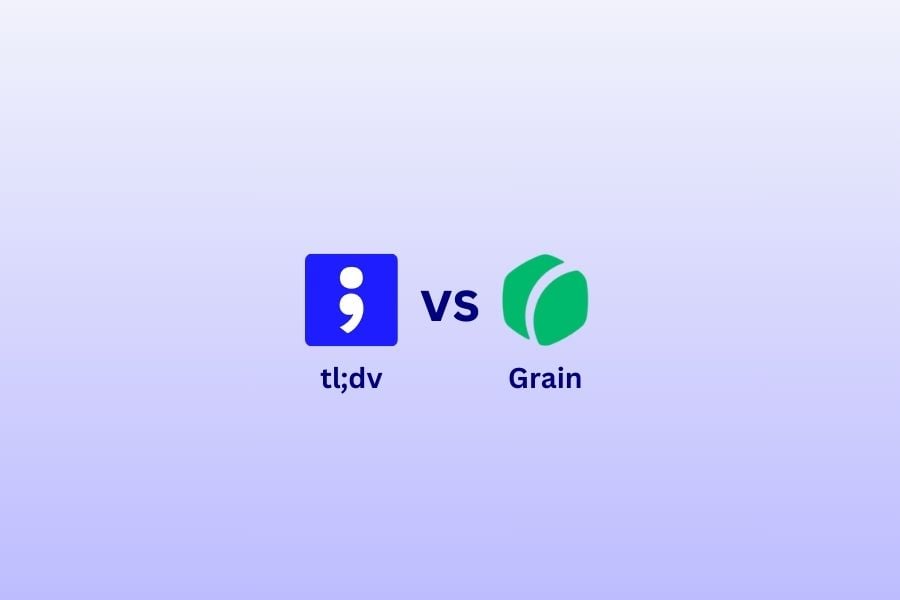Настал момент, которого вы все ждали: tl;dv vs Grain, финальная схватка. К концу этой статьи вы поймете, какой из этих двух гигантов-тяжеловесов лучше для вашего бизнеса.
Чтобы пояснить, оба этих инструмента отлично подходят для записи совещаний, расшифровки звонков и получения информации об искусственном интеллекте после звонка. Однако такое общее утверждение не совсем подходит для этой темы. Мы подробно рассмотрим все категории, которые только можно представить, чтобы сравнить tl;dv и Grain по каждой из имеющихся у них функций.
Если вы еще не уверены, какой из этих двух инструментов должен стать вашим AI-блокнотом для вашей части 55 миллионов совещаний, проводимых каждую неделю (только в США!), то к концу этой статьи вы сможете это сделать.
Так что давайте приступим к делу.
Оглавление
tl;dr
| tl;dv | Grain | |
|---|---|---|
| Транскрипция | 20 | 21 🟢 |
| Запись | 18 🟢 | 14 |
| Технологии для анализа разговоров | 14 🟢 | 11 |
| Автоматизация и интеграции | 10 🟢 | 4 |
| Ведение записей | 10 🟢 | 6 |
| Безопасность | 19 🟢 | 8 |
| Коучинг | 8 🟢 | 0 |
| Администратор | 8 🟢 | 4 |
| Организация | 12 🟢 | 8 |
| Поддержка | 4 🟢 | 2 |
| Аналитика доходов | 0 | 0 |
| Другое | 6 🟢 | 3 |
| Всего | 128 🟢 | 81 |
Судя по приведенным выше результатам, которые мы вскоре рассмотрим подробнее, tl;dv одерживает явную победу. Он набрал 128 баллов по сравнению с достойными 81 баллами Grain.
В основном успех tl;dvобъясняется тем, что в нем есть множество функций для тренировки продаж, в том числе для работы с возражениями, в чем Grain не имеет конкурентов. С помощью tl;dv вы также можете искать и создавать отчеты по нескольким встречам одновременно (а также записывать две или более встреч одновременно). Это выводит ведение заметок с помощью искусственного интеллекта на новый уровень.
tl;dv также отличается своими интеграциями, предлагая все 5 000+ в своем тарифном плане Pro. Grain, с другой стороны, имеет всего 7 собственных интеграций, некоторые из которых (например, Salesforce) открываются только в тарифном плане Business.
Однако Grain занимает первое место по возможностям транскрипции, предлагая самые современные транскрипции в реальном времени, но только для звонков Zoom . Кроме того, в него встроена система удаления слов-заполнителей, которая избавляет транскрипты от беспорядка. Кроме того, в нем есть опция пользовательского словаря, позволяющая пользователям добавлять свои собственные жаргонизмы, чтобы интуитивный искусственный интеллект Grainмог выделить их в транскрипте. Это то, чего сейчас нет у tl;dv , но мы работаем над его внедрением.
Наконец, оба инструмента просты в использовании, но бесплатный план Grainограничен всего 20 встречами и самыми базовыми функциями. tl;dv, с другой стороны, предлагает неограниченное количество записей и расшифровок бесплатно, а также ограниченные версии более продвинутых функций. Это делает его идеальным местом для начала, если вы хотите попробовать, прежде чем покупать.
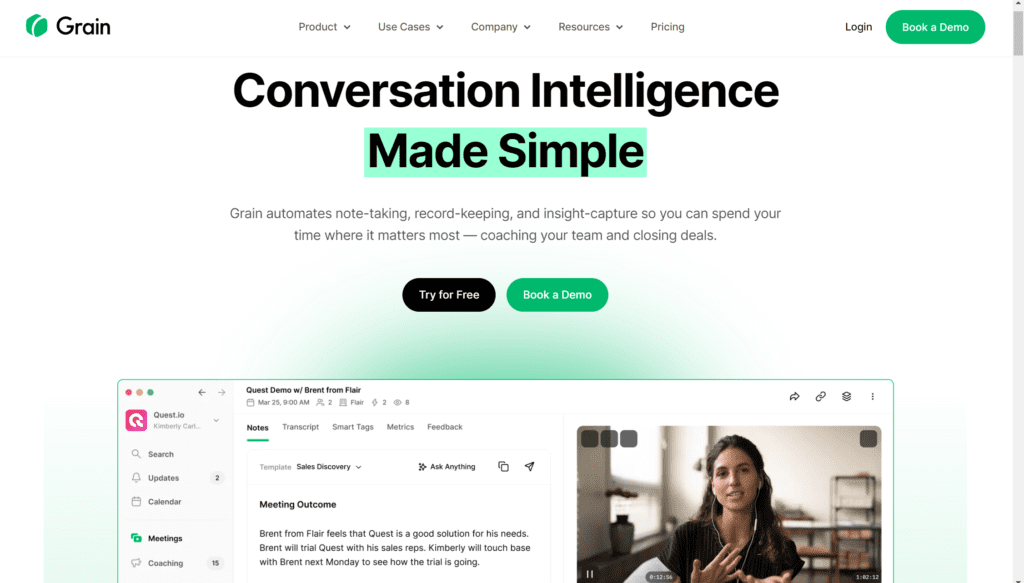
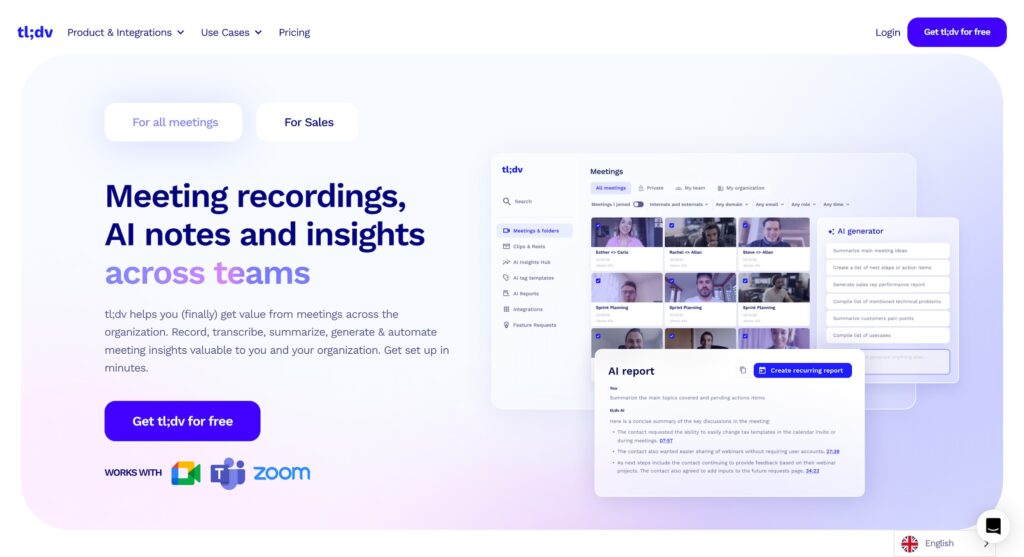
tl;dv vs Grain: 12 факторов, которые следует учитывать при выборе лучшего AI-нотификатора
Как мы оцениваем платформы?
- Мы присуждаем 2 балла платформе, если она выходит явным победителем или если ее функции реализованы в той же мере другой платформой.
- Мы присуждаем 1 балл, если соответствующая функция присутствует, но отстает по качеству.
- Мы ставим 0 баллов, если соответствующая функция отсутствует.
Возможности расшифровки
| tl;dv (20) | Grain (21) | |
|---|---|---|
| Расшифровка звонков включена | 🟢 Безлимит (бесплатно) | 🟠 Безлимит (Стартовый план+) |
| Расшифровка в режиме реального времени | 🔴 | 🟢 (толькоZoom ) |
| Поддерживаемые языки | 🟢 40+ | 🟠 20+ |
| Поддерживаемые диалекты | 🟢 | 🔴 |
| Удаление слов-паразитов | 🔴 скоро | 🟢 |
| Распознавание спикеров | 🟢 | 🟢 |
| Имена участников разговора | 🟢 | 🟢 |
| Расшифровывайте загруженные видео- и аудиофайлы | 🟢 (3 бесплатно, неограниченное количество в Pro) | 🟠 (0 бесплатно, неограниченный бизнес) |
| Экспорт расшифровок | 🟢 | 🟢 |
| Видеоролики из расшифровки | 🟢 | 🟢 |
| Настраиваемый словарь | 🔴 скоро | 🟢 |
| Глобальный поиск по расшифровкам | 🟢 | 🟢 |
| Редактируйте расшифровку | 🟢 | 🟢 |


Транскрипция включена
Первый спорный момент между tl;dv и Grain - это количество транскрипций, к которым вы получаете доступ. С tl;dv вы можете начать работу уже сегодня и получить неограниченное количество бесплатных расшифровок до конца времени. Grain, с другой стороны, предлагает всего 20 встреч. Правда, в стартовом плане он предлагает неограниченное количество, но к этому времени вы уже платите 15 долларов в месяц.
Расшифровка в режиме реального времени
Grain предлагает расшифровку звонков Zoom в режиме реального времени, позволяя пользователям делиться основными моментами во время звонков. Это особенно полезно, если вы работаете в условиях дефицита времени и не можете ждать окончания разговора, чтобы сообщить о нем своей команде.
Транскрипты в реальном времени на tl;dv недоступны, что является ключевым отличием для пользователей, которым важен мгновенный доступ к транскриптам.
Поддерживаемые языки
Транскрипты tl;dvмогут быть переведены на более чем 40 языков, что позволяет удовлетворить потребности глобальных команд, которые работают в многоязычной среде.
Grain предлагает аналогичную функциональность, но уступает в количестве. Вы можете переводить транскрипты Grainна чуть более чем 20 языков. Несмотря на это, если вам нужны услуги транскрипции на более широком спектре языков, то tl;dv выходит на первое место.
Поддерживаемые диалекты
Распознавание диалектов - вот где преимущество tl;dv . Хотя Grain и предлагает пользовательский словарь, о котором мы еще поговорим, он не предлагает никакой поддержки диалектов, что делает его слабым вариантом для команд с тяжелыми диалектами.
Здесь tl;dv превосходит всех, обеспечивая повышенную точность транскрипции для пользователей с различными диалектами. Короче говоря, он обеспечивает точную передачу нюансов региональных акцентов, что невозможно при использовании Grain.
Удаление слов-паразитов
Grain предлагает удаление слов-заполнителей, гарантируя, что в вашей стенограмме не будет "эээ" и "эррр". Он по-прежнему включает в себя слова-заполнители, такие как "как" и другие реальные слова-заполнители. tl;dv, однако, пока не предлагает никакого удаления слов-заполнителей.
Стоит отметить, что в дорожной карте tl;dv есть функция удаления слов-заполнителей, и пройдет совсем немного времени, и вы сможете создавать более чистые и лаконичные транскрипты, удаляя ненужные слова и фразы.
Расшифровка загружаемых видео/аудиофайлов
Обе платформы позволяют транскрибировать загруженные аудио- и видеофайлы. Однако Grain вообще не предлагает эту функцию в бесплатном тарифном плане и обеспечивает неограниченную загрузку файлов только в бизнес-плане.
tl;dv дает вам 3 бесплатные загрузки, чтобы вы могли поиграть с этой функцией, прежде чем принять решение. Кроме того, в тарифном плане Pro неограниченное количество загрузок будет доступно раньше, чем Grain тарифном плане Grain.
Настраиваемый словарь
Grain Предлагает пользовательский словарь, позволяющий пользователям добавлять собственные слова в словарь искусственного интеллекта, чтобы в будущем они отображались в стенограмме. Это идеально подходит для команд, которые используют в своих звонках много жаргонизмов. Это особенность, которую еще не реализовали многие конкуренты.
tl;dv - один из них. Хотя эта функция еще не добавлена, она находится в разработке. tl;dv намерен в ближайшем будущем повысить точность и релевантность транскрипции для специализированных областей или терминологий.
В то же время, если эта функция необходима, то Grain - это тот инструмент, к которому стоит обратиться.
Возможности записи
| tl;dv (18) | Grain (14) | |
|---|---|---|
| Видеоплатформы | 🟢 Zoom, MS Teams, Google Meet | 🟢 Zoom, MS Teams, Google Meet |
| Хранение | 🟢 Безлимитный | 🟢 Безлимитный |
| Записывает видео | 🟢 | 🟢 |
| Параллельные встречи | 🟢 Безлимитный | 🔴 |
| Скачивание записей | 🟢 | 🟢 |
| Запись слайдов | 🟢 | 🔴 |
| Просмотр аналитики | 🟢 | 🔴 |
| Интегрированный календарь | 🟢 | 🟢 |
| Запись Редактирование | 🔴 | 🟢 |
| Ролики | 🟢 | 🟢 |
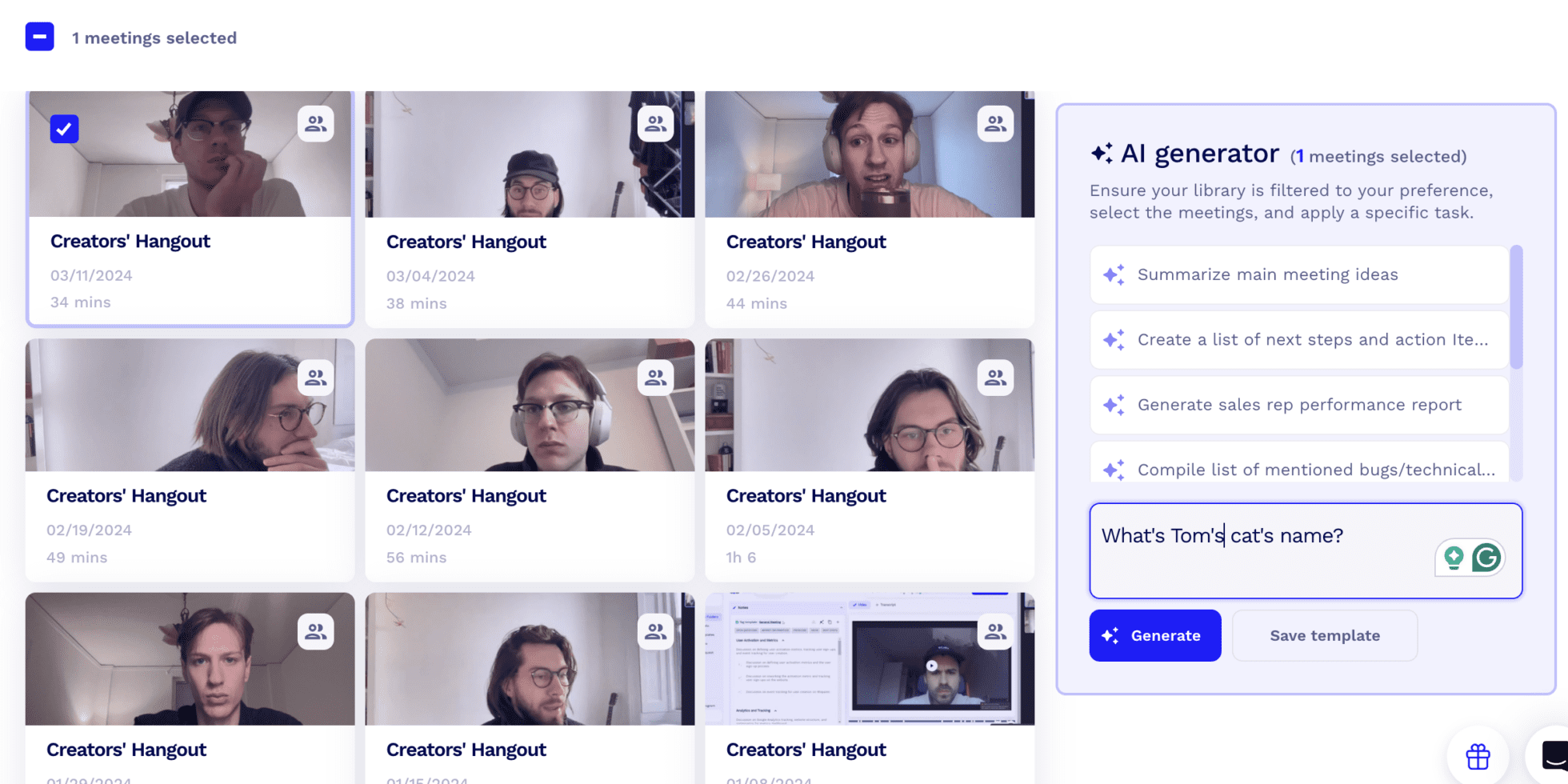
Записывает видео
И tl;dv , и Grain позволяют пользователям записывать видео в своих бесплатных планах. Это важная функция, которая позволяет пользователям не только читать стенограмму, но и пересматривать свои встречи. С ее помощью пользователи могут определять язык тела, что особенно важно во время переговоров по продажам или исследования пользователей.
Как уже упоминалось ранее, tl;dv предлагает неограниченное количество бесплатных записей, в то время как Grain ограничивает количество бесплатных пользователей 20 встречами.
Параллельные встречи
tl;dv опережает Grain , позволяя пользователям записывать несколько встреч одновременно. Если у вас двойная (или тройная+) встреча, tl;dv может записать все эти встречи одновременно. Если у вас напряженный график, tl;dv станет незаменимым помощником, чтобы не пропустить ни одной встречи.
Grain присоединяется только к одному собранию за раз, что существенно ограничивает его возможности по оказанию помощи занятым командам, проводящим несколько одновременных собраний.
Запись слайдов
tl;dv позволяет пользователям захватывать слайды во время совещания, обеспечивая включение в запись наглядных пособий и презентаций. Это отлично подходит для совещаний, на которых главный докладчик делится своим экраном, поскольку обеспечивает ценный контекст и более полную запись совещания в целом. Это также отлично подходит для образовательных целей и совместной работы, поскольку каждый участник впоследствии получает доступ к основному компоненту обсуждения.
Grain не имеет такой возможности. Пользователи, записывающие с помощью Grain , могут упустить важные визуальные элементы во время совещания.
Просмотр аналитики
tl;dv предлагает своим пользователям аналитику просмотра, чтобы они могли получить представление о том, как их команда использует записи совещаний. Эта функция призвана помочь командам понять, насколько эффективны их встречи и как потребляется контент, что открывает возможность принятия решений, основанных на данных, для улучшения последующих встреч.
Grain не позволяет пользователям анализировать вовлеченность во встречи, не предлагая аналитику просмотра.
Запись Редактирование
Grain опережает tl;dv , предлагая возможности редактирования записи, которые позволяют пользователям улучшать и редактировать записи совещаний после захвата. Эта функция особенно полезна для создания полированного контента, которым можно поделиться, или для обрезки ненужных сегментов перед распространением.
В настоящее время tl;dv не предлагает редактирование записей, сосредоточившись на предоставлении полного набора других функций записи и расшифровки. Тем не менее, он позволяет создавать клипы и основные моменты.
Возможности интеллектуального анализа разговоров
| tl;dv (14) | Grain (11) | |
|---|---|---|
| ИИ-аналитика одной встречи | 🟢 | 🟢 |
| ИИ-аналитика по нескольким встречам | 🟢 | 🔴 |
| Отслеживание ключевых слов | 🟢 | 🟠 в Бизнес-плане+ |
| Анализ настроений | 🔴 Нет, в соответствии с Законом ЕС об искусственном интеллекте | 🔴 |
| Обнаружение ключевых тем | 🟢 | 🟢 |
| Речевая аналитика | 🟢 | 🟢 |
| Распознавание задач | 🟢 | 🟢 |
| Обнаружение вопросов | 🟢 | 🟢 |
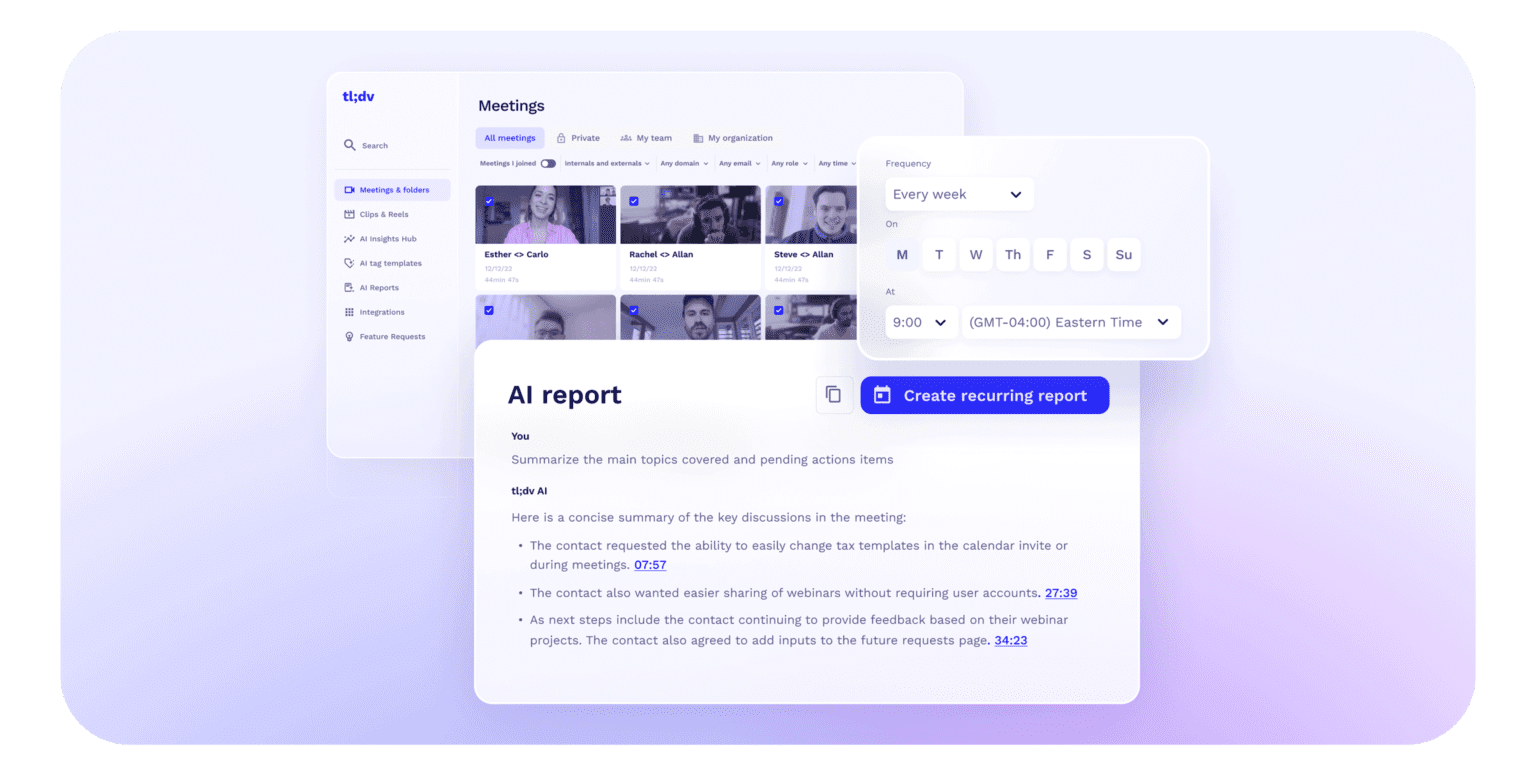

ИИ-анализ на основе многочисленных совещаний
tl;dv выделяется на фоне других ИИ-блокнотов, включая Grain, тем, что позволяет анализировать несколько встреч. Вы можете планировать повторяющиеся отчеты на основе ряда фильтров, которые будут анализировать несколько встреч одновременно и предоставлять вам информацию обо всех из них.
Это идеальный вариант для отделов продаж, проводящих несколько звонков в день. Вместо того чтобы сидеть над каждым звонком или получать резюме ИИ по каждому звонку, tl;dv позволяет вам получить отчет ИИ по всей партии звонков за день (или неделю, или месяц). Таким образом, вы сможете быстро выявить закономерности, тенденции, положительные моменты, на которые следует обратить внимание, и типичные подводные камни, которых следует избегать.
Grain не предлагает этой функции, не позволяя вывести команды на новый уровень с помощью ИИ-интуиции и автоматизации.
Отслеживание ключевых слов
tl;dv предлагает функцию отслеживания ключевых слов, позволяя пользователям следить за определенными терминами на всех встречах. Это помогает командам отслеживать важные темы или выполнять последующие действия по важным вопросам.
Grain тоже предлагает отслеживание ключевых слов, но эта функция ограничена тарифным планом "Бизнес". Это может быть недоступно отдельным пользователям или небольшим командам, что потенциально ограничивает их возможности по отслеживанию и эффективному анализу конкретных моментов обсуждения.
Речевая аналитика
Функция Speaker Insights от tl;dvпомогает командам понять эффективность своих встреч. Для отделов продаж эта функция позволяет отслеживать соотношение времени разговора и прослушивания, а также другие показатели, такие как вопросы в час, слова в минуту и даже слова-заполнители в минуту. Это позволяет пользователям использовать достоверные данные, чтобы подчеркнуть, что сработало хорошо, а что нуждается в улучшении.
Grain В тарифном плане "Бизнес" также предлагается аналитика речи, позволяющая пользователям оценить, как их команда взаимодействует при различных звонках.
Возможности автоматизации и интеграции
| tl;dv (10) | Grain (4) | |
|---|---|---|
| Интеграции с CRM | 🟢 в плане Pro | 🟠 в Бизнес-плане |
| Интеграции с электронной почтой | 🟢 | 🔴 |
| Интеграции с Zapier | 🟢 в плане Pro | 🟢 в стартовом плане |
| Сводки по встречам, отправляемые участникам по электронной почте после встречи | 🟢 автоматический | 🟠 1 клик |
| Отчеты по расписанию | 🟢 | 🔴 |

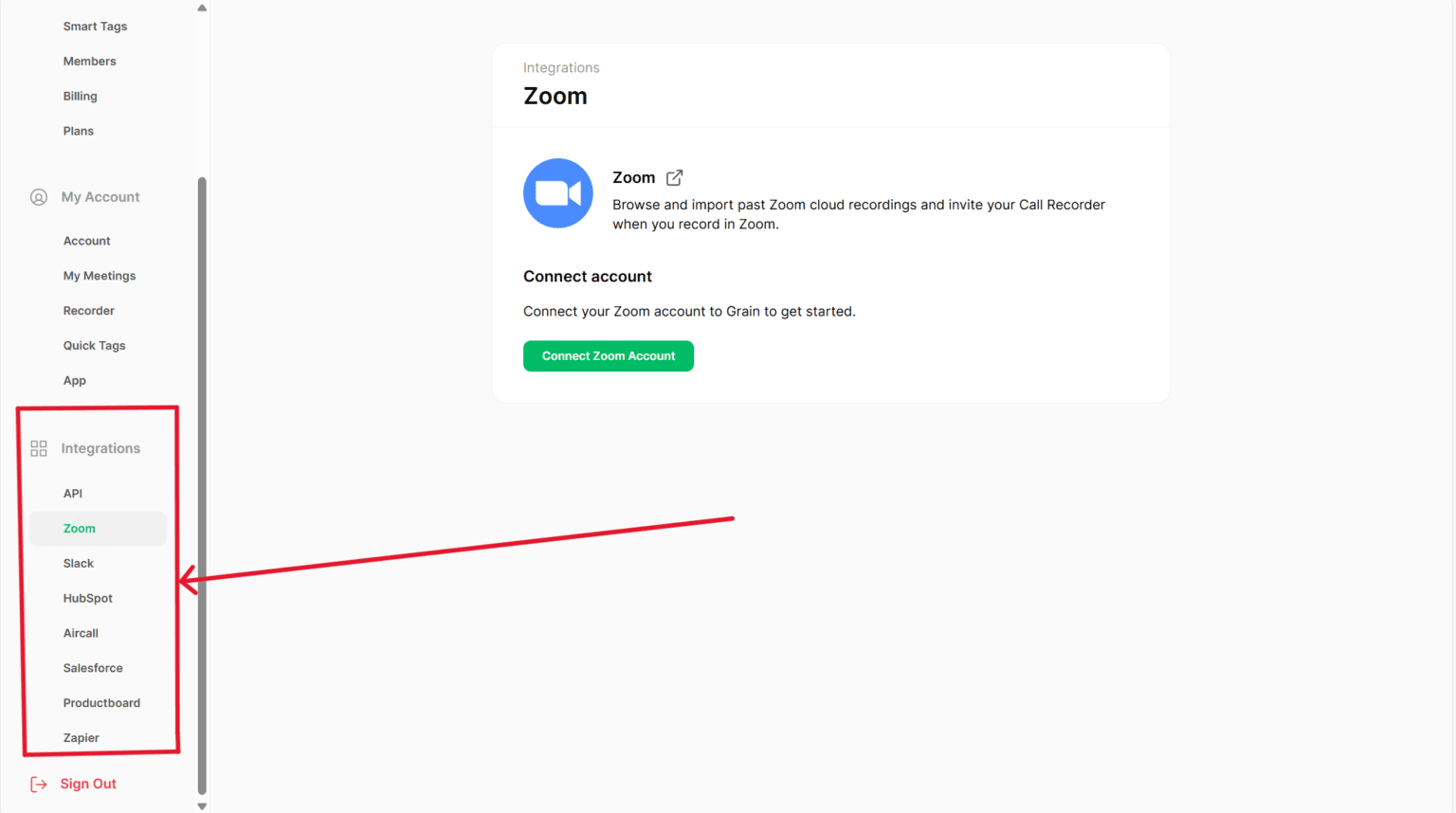
Интеграции с CRM
Все встроенные интеграции tl;dv, включая CRM, такие как Salesforce, Hubspot и Pipedrive, доступны в тарифном плане Pro. Это позволяет командам любого размера оптимизировать рабочий процесс и автоматизировать утомительные процессы.
Grain, с другой стороны, ограничивает эту функцию тарифным планом "Бизнес" и предоставляет ограниченные возможности CRM по сравнению с tl;dv. В ней есть интеграция с Zapier, которую можно использовать для подключения к другой CRM по вашему выбору. Однако это дополнительный шаг и требует привлечения третьей стороны. Кроме того, tl;dv также предлагает интеграцию с Zapier, если выбранная вами CRM не включена в 5 000+ встроенных интеграций.
Интеграции с электронной почтой
tl;dv предлагает бесплатную интеграцию с электронной почтой. Это означает, что записи и стенограммы ваших встреч будут автоматически отправляться на вашу электронную почту (и на почту всех участников) после завершения разговора.
Grain не интегрируется ни с одним поставщиком услуг электронной почты. Если вы хотите отправить запись или стенограмму по электронной почте, это можно сделать в один клик, но не автоматически.
Интеграции с Zapier
И tl;dv , и Grain предлагают интеграцию с Zapier. Zapier - это популярный инструмент интеграции, который соединяет различные SaaS-приложения друг с другом, что делает его очень ценным, если нет собственной интеграции.
Сводки по встречам, отправляемые участникам по электронной почте
Все участники звонка, tl;dv, сразу после окончания разговора получат на свой почтовый ящик письмо с кратким содержанием встречи. В нем будут освещены основные темы и указаны временные метки, чтобы пользователь мог быстро и легко просмотреть определенные моменты.
Grain не предлагает автоматической отправки резюме после встречи по электронной почте, однако вы можете отправить запись и стенограмму в последующем письме с помощью нескольких простых щелчков мыши.
Отчеты по расписанию
tl;dv позволяет пользователям планировать повторяющиеся отчеты, которые охватывают несколько встреч в одном подробном отчете, наполненном аналитикой, мнениями и многим другим. Вы можете отфильтровать нужные встречи по ключевым словам, темам, участникам и т. д.
Grain не позволяет пользователям планировать отчеты. Они могут получить сводку AI по отдельной встрече, но не регулярные отчеты по нескольким встречам. Это потенциально мешает платформе делать какие-либо значимые выводы по широкому спектру звонков.
Возможность ведения заметок
| tl;dv (10) | Grain (6) | |
|---|---|---|
| ИИ-заметки | 🟢 | 🟢 |
| Заметки вручную во время разговора | 🟢 требуется приложение | 🟠 нужно приложение (толькоZoom ) |
| Отмечайте людей в заметках | 🟢 | 🔴 |
| Назначайте задания | 🔴 | 🔴 |
| Теги ИИ / Закладки | 🟢 (Бесплатно) | 🟠 (Бизнес+) |
| Комментарии | 🟢 | 🟢 |
ИИ-заметки
И Grain , и tl;dv предлагают заметки с искусственным интеллектом, позволяя пользователям в первую очередь сосредоточиться на разговоре. Это отлично подходит для поддержания концентрации во время важных звонков, поскольку вы можете быть уверены, что искусственный интеллект уловит все важные моменты, которые вам нужно запомнить.
Заметки вручную во время разговора
Если вам нужно сделать заметку о чем-то незначительном, что ИИ обычно не замечает, вы можете сделать это и с помощью tl;dv , и с помощью Grain , если у вас есть соответствующие приложения. Однако приложение Grainсовместимо только со звонками Zoom , что может стать помехой для команд, использующих другие платформы для видеоконференций.
Пометить людей в заметках
tl;dv позволяет пользователям отмечать коллег или значимых людей в примечаниях к стенограмме. Отмеченные люди получают электронное письмо, отправленное прямо на их почтовый ящик, с временной меткой конкретной заметки. Это позволяет им сразу перейти к нужной части.
Grain не позволяет пользователям отмечать людей в заметках, что делает более утомительным показ коллеге конкретных сведений из записи.
Теги ИИ
Оба инструмента поддерживают теги AI, позволяющие пользователям быстро и легко делать закладки и пересматривать важные фрагменты встречи. Эта функция доступна на всех тарифных планах tl;dv, включая тарифный план Free.
Grain предлагает Smart Tags (трекеры), но только для тарифных планов Business и Enterprise. Эта функция повышает эффективность просмотра записей и заметок совещаний, значительно упрощая поиск по прошедшим встречам. Однако ограничение этой опции только тарифным планом Business может лишить рядовых пользователей возможности беспрепятственно просматривать свои встречи.
Обеспечение безопасности
| tl;dv (19) | Grain (8) | |
|---|---|---|
| Сохранение данных | 🟠 6 месяцев на БЕСПЛАТНОМ тарифном плане Безлимит на всех платных планах | 🔴 не разглашается |
| Соответствие требованиям SOC2 | 🔴 (идет сертификация) | 🟢 |
| SSO на основе SAML | 🟢 Только на Enterprise | 🟢 Только на Enterprise |
| Соответствие требованиям GDPR | 🟢 | 🔴 не разглашается |
| Соответствие закону ЕС об искусственном интеллекте | 🟢 | 🔴 не разглашается |
| Использование ваших данных для обучения искусственного интеллекта | 🟢 (Нет, ваши данные будут сохранены в тайне) | 🟢 (Нет, ваши данные будут сохранены в тайне) |
| Частное хранилище | 🟢 Только на Enterprise | 🔴 не разглашается |
| Анонимизированные конфиденциальные данные, отправленные на LLM | 🟢 | 🟢 |
| Фрагментация и рандомизация данных по встрече | 🟢 | 🔴 не разглашается |
| BAA с поставщиками услуг LLM | 🟢 | 🔴 не разглашается |
| Политика хранения данных у сторонних поставщиков - 0 дней | 🟢 | 🔴 не разглашается |
Сохранение данных
tl;dv предлагает четкую политику хранения данных, гарантируя 6 месяцев хранения данных для пользователей бесплатного тарифного плана и неограниченное хранение данных для всех платных тарифных планов.
Прозрачность политики хранения данных крайне важна для организаций, управляющих конфиденциальной информацией. В отличие от этого, Grain не раскрывает политику хранения данных на совещаниях, что может вызвать опасения у пользователей с жесткими требованиями к управлению данными.
Соответствие требованиям SOC2
Компания tl;dv находится на пути к получению статуса SOC2, что подчеркивает ее стремление к достижению высоких стандартов безопасности и защиты данных, а компания Grain уже соответствует требованиям SOC2.
Эта сертификация обеспечивает пользователям Grainдополнительный уровень доверия и надежности.
Соответствие требованиям GDPR
tl;dv соответствует требованиям GDPR, что обеспечивает соблюдение строгих правил Европейского союза по защите данных и конфиденциальности.
Grain не раскрывает, соответствует ли она требованиям GDPR, что делает ее рискованным шагом для тех, кто серьезно относится к защите данных.
Соответствие закону ЕС об искусственном интеллекте
Компания tl;dv, расположенная в ЕС и имеющая серверы в Европе, соответствует Закону ЕС об искусственном интеллекте, что свидетельствует о ее приверженности этическим нормам искусственного интеллекта и соблюдению нормативных требований.
Соответствует ли сайт Grain Закону ЕС об искусственном интеллекте, пока неизвестно, что может быть важным фактором для пользователей, работающих на территории ЕС или заинтересованных в соблюдении норм ЕС.
Частное хранилище
Частное хранилище - важная функция для компаний, которые ставят во главу угла суверенитет и безопасность данных. Она доступна в tl;dv для всех пользователей Enterprise.
Grain не рекламирует функцию частного хранилища, что, скорее всего, означает, что у нее ее нет. Это может повлиять на процесс принятия решений для крупных организаций с особыми потребностями в хранении данных.
Политика хранения данных в течение 0 дней
tl;dv удаляет или анонимизирует данные сразу после того, как они были использованы по назначению. Это подчеркивает позицию tl;dvпо минимизации воздействия на данные. Кроме того, эти рекомендации объясняются в понятной форме, которую легко найти и понять пользователям.
Grain не раскрывает такой политики, что может создать проблемы для пользователей со строгой политикой управления данными.
Возможности коучинга
| tl;dv (8) | Grain (0) | |
|---|---|---|
| Оценочные карты для руководств | 🟢 | 🔴 |
| Настраиваемые руководства | 🟢 | 🔴 |
| Шаблоны руководств | 🟢 | 🔴 |
| Работа с возражениями | 🟢 | 🔴 |
Если вы хотите, чтобы регистратор встреч помог вам улучшить качество продаж, tl;dv - единственный реальный вариант. Он предоставляет постоянно расширяющийся набор возможностей для коучинга, от playbooks до работы с возражениями, которые Grain просто не в состоянии удовлетворить. Вот четыре основные области коучинга в tl;dv:
- Playbooks Оценочные листы: Оценочные листы помогают отслеживать и оценивать индивидуальные или командные показатели во время совещаний, предлагая идеи для личного совершенствования. Пользователи могут создать оценочный лист для любой выбранной группы совещаний, что позволяет отслеживать и анализировать эффективность работы в течение нескольких сессий.
- Пользовательские Playbooks: Пользователи могут свободно устанавливать свои собственные рекомендации и лучшие практики для проведения эффективных совещаний. Применяя эти пользовательские playbooks, пользователи могут направлять и оценивать проведение любого совещания (или серии совещаний), обеспечивая последовательность и следование проверенным стратегиям.
- Шаблоны руководствУ tl;dv есть множество готовых шаблонов, которые команды могут адаптировать к своим стратегиям коучинга.
- Продукт (исследовательское интервью, пользовательское тестирование).
- Проект (планирование спринта, совещание, мозговой штурм, запуск)
- HR (собеседование при приеме на работу, выходное собеседование, входное собеседование).
- Customer Success (Ретроспективное совещание, бизнес-обзор, совещания по введению клиентов в должность, совещания по проверке клиентов, обратная связь).
- Продажи (Demo call, MEDDIC, SPICED, BANT, Discovery call, GPCT, CHAMP, ANUM, BEBEDC, SPIN).
- Управление(план повышения эффективности, встреча 1:1, увольнение 1:1, оценка эффективности).
Обработка возражений: Эта функция предоставляет командам по продажам и CS подробную оценку эффективности, сфокусированную на том, как они реагируют на возражения клиентов. Она использует данные о встречах и информацию для создания оценочных листов, которые выявляют сильные и слабые стороны в навыках работы с возражениями, помогая командам совершенствовать свои методы - и все это в рамках платформы.
Возможности администратора
| tl;dv (8) | Grain (4) | |
|---|---|---|
| Используйте автоматическую запись всех встреч в календаре членов команды | 🟢 | 🟠 (только ваши встречи) |
| Используйте автоматическую пересылку встреч, записанных членами команды | 🟢 | 🟠 (только ваши встречи) |
| Предотвращение удаления | 🟢 | 🔴 |
| Права администратора на все записи | 🟢 | 🟢 |

Автоматическая запись всех встреч в календаре членов команды
tl;dv позволяет администраторам организовать автоматическую запись всех встреч, запланированных в календарях членов команды. Это обеспечивает подробный обзор обсуждений и решений, которые впоследствии можно превратить в отчеты. Эта функция необходима для обеспечения подотчетности и обмена знаниями.
В отличие от этого, Grain не предоставляет администраторам таких полномочий, оставляя все на усмотрение пользователей. Это может быть проблематично для руководителей, которые хотят гарантировать, что все встречи будут записаны. Grain позволяет пользователям автоматически записывать все встречи, но только из их собственного календаря.
Автообмен встречами в календаре членов команды
Администраторы, использующие tl;dv , могут автоматически предоставлять общий доступ к собраниям, записанным членами команды, что делает процесс распространения собраний плавным и упорядоченным. Эта функция улучшает совместную работу всей организации. Заинтересованные стороны также получают мгновенный доступ к записям через автоматически распространяемые собрания, что экономит их время и энергию.
Grain Grain позволяет пользователям автоматически делиться встречами, но только из собственного календаря.
Предотвращение удаления
Эта непритязательная функция на самом деле очень важна. Возможность администраторов предотвращать удаление дает огромную уверенность отделам продаж, так как есть представители, которые могут удалять записи звонков до того, как у администраторов появится возможность их просмотреть. Предотвращая удаление, tl;dv позволяет администраторам контролировать все звонки по продажам во всей организации, что обеспечивает дополнительную подотчетность и доверие.
Grain Не хватает этой функции, чтобы человек, записавший каждый звонок, имел право решать, что будет удалено, а что нет, оставляя администраторов в неведении.
Права администратора на все записи
tl;dv позволяет администраторам иметь права на все записи, что делает их контролерами всех собраний в вашей организации. Это упрощает управление.
Grain также позволяет администраторам иметь права на все записи через рабочее пространство для совместной работы. Это очень удобно для больших команд, поскольку администратор может контролировать все собрания из одного рабочего пространства.
Организационные возможности
| tl;dv (12) | Grain (8) | |
|---|---|---|
| Командные рабочие пространства | 🟢 | 🟢 |
| Библиотека встреч | 🟢 | 🟢 |
| Интеллектуальные фильтры | 🟢 | 🔴 |
| Глобальный поиск | 🟢 | 🔴 |
| Поиск по встречам | 🟢 | 🟢 |
| Папки | 🟢 | 🟢 |
Командные рабочие пространства
Grain есть рабочее пространство для совместной работы, в котором вы можете работать всей командой. Это доступно начиная с бесплатного плана и выше, но доступ администратора открывается только в плане Starter.
tl;dv также предлагает командные рабочие пространства на всех своих тарифных планах, включая тарифный план Free Forever. Эта функция позволяет командам беспрепятственно сотрудничать и обмениваться контентом в своем собственном выделенном пространстве.
Интеллектуальные фильтры
tl;dv помогает пользователю эффективно сортировать критерии встреч с помощью функции Smart Filters. Благодаря этой функции поиск информации о встречах становится очень простым, что позволяет вашей команде не упустить ни одной важной детали.
Grain не содержит интеллектуальных фильтров, что снижает его организационные возможности и усложняет сортировку и поиск информации для пользователей.
Глобальный поиск
tl;dv позволяет пользователям осуществлять поиск по всей библиотеке встреч, чтобы найти точные моменты из звонков. Вы можете искать по ключевым словам или даже найти что-то из своих заметок или комментариев.
Grain не позволяет пользователям осуществлять поиск по всем своим встречам сразу, что значительно снижает их способность быстро находить важную информацию.
Папки
tl;dv позволяет пользователям организовывать свои встречи так, как они считают нужным. Папки позволяют командам разбивать различные встречи на разные категории. Стоит отметить, что функция командных папок открывается только в тарифном плане Pro.
GrainФункция "Плейлист" делает то же самое. В бесплатном плане Grain позволяет пользователям организовывать встречи в папки с самого начала, что делает его отличным вариантом для команд, которые любят упорядоченную организацию.
Возможности поддержки
| tl;dv (4) | Grain (2) | |
|---|---|---|
| Поддержка в бесплатном плане | 🟢 чат и электронная почта | 🟠 Электронная почта в тарифном плане Free |
| Приоритетная поддержка | 🟢 в плане Pro | 🟠 Только в тарифном плане Enterprise |
Поддержка в бесплатном плане
На тарифном плане Free компания tl;dv предлагает быструю и эффективную поддержку через онлайн-чат и электронную почту. У пользователей есть несколько каналов для поиска помощи, необходимой для решения их проблем, а значит, у них всегда есть возможность связаться с кем-то, когда им это нужно. Этот метод не дискриминирует людей с более низким уровнем подписки.
Grain также предлагает бесплатную поддержку, но только в форме электронной почты. Из-за отсутствия онлайн-чата бесплатные пользователи Grainмогут рассчитывать на более длительное время ответа по сравнению с tl;dv.
Приоритетная поддержка
Приоритетная поддержка tl;dvначинается с тарифного плана Pro, предлагая более быстрое и полное обслуживание клиентов в первом платном варианте.
GrainПриоритетная поддержка не работает, если вы не являетесь владельцем тарифного плана Enterprise. Все остальные подписчики должны ждать поддержки по электронной почте, что может быть довольно неприятно, особенно в выходные дни или в периоды загруженности.
Возможности анализа доходов
| tl;dv (0) | Grain (0) | |
|---|---|---|
| Прогнозирование | 🔴 | 🔴 |
| Заключение сделок | 🔴 | 🔴 |
Ни tl;dv , ни Grain не предлагают функций, связанных с анализом доходов, таких как прогнозирование и заключение сделок. Пользователям, которые ищут специализированные инструменты для продаж, придется искать их в другом месте, однако эти инструменты не дешевы. Стоимость инструментов для анализа доходов часто составляет более 1 000 долларов США на пользователя и может резко возрастать в зависимости от дополнительных функций, необходимых вашей команде.
Если вам нужен инструмент для анализа доходов, чтобы улучшить навыки продаж вашей команды, обратите внимание на инновационное решение tl;dvдля коучинга, которое использует данные о звонках по продажам, чтобы предложить стратегические улучшения.
Для кого это?
| tl;dv (6) | Grain (3) | |
|---|---|---|
| Рейтинг G2 | 🟢 4.7 | 🔴 4.6 |
| Простота установки | 🟢 Щедрый бесплатный план + простой пользовательский интерфейс | 🟠 Легкий, но ограниченный бесплатный план. |
| Локализованная платформа | 🟢 (7 языков) | 🔴 |
| Кому лучше всего подходит | 🟢 Продажи - малый и средний бизнес | 🟢 Продажи - малый и средний бизнес |
tl;dv и Grain предназначены для отделов продаж малого и среднего бизнеса, что делает их идеальными помощниками для торговых представителей в англоязычных странах и за их пределами. Функции коучинга в tl;dvдают ему преимущество для команд в своей общей нише.
Если вашей команде требуется локализованная платформа на нескольких языках, Grain - не та платформа, которую стоит использовать. tl;dv, однако, имеет локализованную платформу на 7 различных языках, что делает ее отличным решением для международных отделов продаж или глобальных маркетинговых команд, которым требуется несколько языков.
Оба инструмента достаточно просты для начала работы. Создать аккаунт и записать свою первую встречу можно за считанные мгновения. Разница в том, что tl;dv позволяет использовать самые базовые функции (запись и транскрибацию) бесконечно без оплаты. Grain ограничивает даже эти самые базовые функции всего 20 встречами.
Вердикт: tl;dv vs Grain - что лучше?
| tl;dv | Grain | |
|---|---|---|
| Транскрипция | 20 | 21 🟢 |
| Запись | 18 🟢 | 14 |
| Технологии для анализа разговоров | 14 🟢 | 11 |
| Автоматизация и интеграции | 10 🟢 | 4 |
| Ведение записей | 10 🟢 | 6 |
| Безопасность | 19 🟢 | 8 |
| Коучинг | 8 🟢 | 0 |
| Администратор | 8 🟢 | 4 |
| Организация | 12 🟢 | 8 |
| Поддержка | 4 🟢 | 2 |
| Аналитика доходов | 0 | 0 |
| Другое | 6 🟢 | 3 |
| Всего | 128 🟢 | 81 |
Grain оказывает достойное сопротивление и набирает 81 балл, но именно tl;dv выходит на первое место, набрав 128 баллов.
Однако выбор между tl;dv и Grain не так прост. Все зависит от конкретных потребностей вашего бизнеса. Grain предлагает несколько отличных функций, которых нет у tl;dv : транскрипция в реальном времени, удаление слов-заполнителей, редактирование записи и пользовательский словарь. Grain- это фантастический инструмент, если вам нужна высококачественная расшифровка.
Однако если для вас и вашей команды более важен плавный пользовательский интерфейс, почти в 1000 раз больше встроенных интеграций, поддержка одновременных встреч (и интеллектуальное управление несколькими встречами), отслеживание ключевых слов, интеллектуальные фильтры и мощные ресурсы для коучинга, то tl;dv - это лучший выбор.
Коучинг, playbooks и функции работы с возражениями - вот что делает tl;dvна голову выше других команд по продажам.
Наконец, tl;dv лучше подходит для асинхронных многонациональных команд благодаря своей многоязычной локализованной платформе и большему количеству языков перевода транскриптов.
В конечном счете, выбор за вами и только за вами. Какой бы инструмент ни помог вам больше всего поднять бизнес, именно его вы должны использовать. Какой бы инструмент вы ни выбрали, вы уже на пути к использованию интеллектуального ИИ для оптимизации, организации и автоматизации рабочих процессов.

